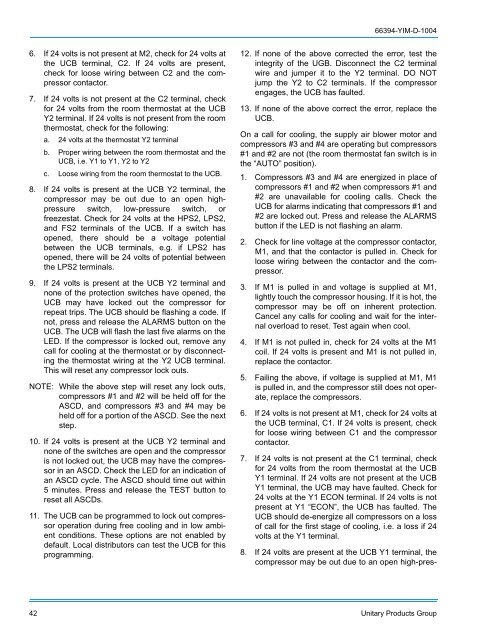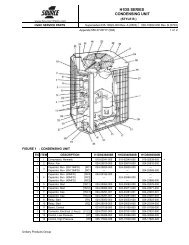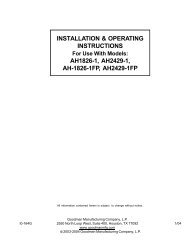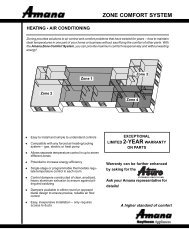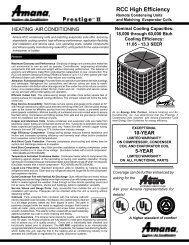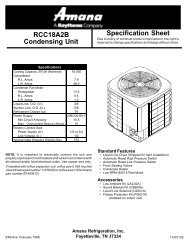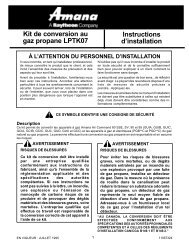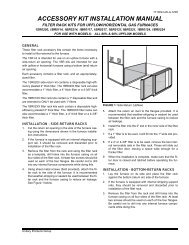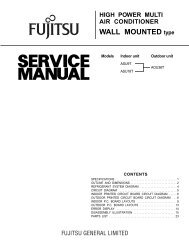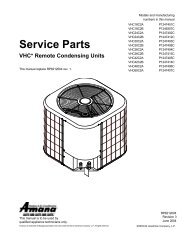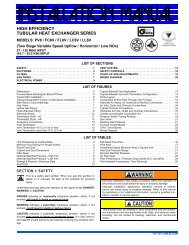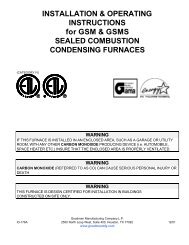Y-IM, BQ240 Sunline 2000 Single Package Heat Pump
Y-IM, BQ240 Sunline 2000 Single Package Heat Pump
Y-IM, BQ240 Sunline 2000 Single Package Heat Pump
Create successful ePaper yourself
Turn your PDF publications into a flip-book with our unique Google optimized e-Paper software.
66394-Y<strong>IM</strong>-D-1004<br />
6. If 24 volts is not present at M2, check for 24 volts at<br />
the UCB terminal, C2. If 24 volts are present,<br />
check for loose wiring between C2 and the compressor<br />
contactor.<br />
7. If 24 volts is not present at the C2 terminal, check<br />
for 24 volts from the room thermostat at the UCB<br />
Y2 terminal. If 24 volts is not present from the room<br />
thermostat, check for the following:<br />
a. 24 volts at the thermostat Y2 terminal<br />
b. Proper wiring between the room thermostat and the<br />
UCB, i.e. Y1 to Y1, Y2 to Y2<br />
c. Loose wiring from the room thermostat to the UCB.<br />
8. If 24 volts is present at the UCB Y2 terminal, the<br />
compressor may be out due to an open highpressure<br />
switch, low-pressure switch, or<br />
freezestat. Check for 24 volts at the HPS2, LPS2,<br />
and FS2 terminals of the UCB. If a switch has<br />
opened, there should be a voltage potential<br />
between the UCB terminals, e.g. if LPS2 has<br />
opened, there will be 24 volts of potential between<br />
the LPS2 terminals.<br />
9. If 24 volts is present at the UCB Y2 terminal and<br />
none of the protection switches have opened, the<br />
UCB may have locked out the compressor for<br />
repeat trips. The UCB should be flashing a code. If<br />
not, press and release the ALARMS button on the<br />
UCB. The UCB will flash the last five alarms on the<br />
LED. If the compressor is locked out, remove any<br />
call for cooling at the thermostat or by disconnecting<br />
the thermostat wiring at the Y2 UCB terminal.<br />
This will reset any compressor lock outs.<br />
NOTE: While the above step will reset any lock outs,<br />
compressors #1 and #2 will be held off for the<br />
ASCD, and compressors #3 and #4 may be<br />
held off for a portion of the ASCD. See the next<br />
step.<br />
10. If 24 volts is present at the UCB Y2 terminal and<br />
none of the switches are open and the compressor<br />
is not locked out, the UCB may have the compressor<br />
in an ASCD. Check the LED for an indication of<br />
an ASCD cycle. The ASCD should time out within<br />
5 minutes. Press and release the TEST button to<br />
reset all ASCDs.<br />
11. The UCB can be programmed to lock out compressor<br />
operation during free cooling and in low ambient<br />
conditions. These options are not enabled by<br />
default. Local distributors can test the UCB for this<br />
programming.<br />
12. If none of the above corrected the error, test the<br />
integrity of the UGB. Disconnect the C2 terminal<br />
wire and jumper it to the Y2 terminal. DO NOT<br />
jump the Y2 to C2 terminals. If the compressor<br />
engages, the UCB has faulted.<br />
13. If none of the above correct the error, replace the<br />
UCB.<br />
On a call for cooling, the supply air blower motor and<br />
compressors #3 and #4 are operating but compressors<br />
#1 and #2 are not (the room thermostat fan switch is in<br />
the “AUTO” position).<br />
1. Compressors #3 and #4 are energized in place of<br />
compressors #1 and #2 when compressors #1 and<br />
#2 are unavailable for cooling calls. Check the<br />
UCB for alarms indicating that compressors #1 and<br />
#2 are locked out. Press and release the ALARMS<br />
button if the LED is not flashing an alarm.<br />
2. Check for line voltage at the compressor contactor,<br />
M1, and that the contactor is pulled in. Check for<br />
loose wiring between the contactor and the compressor.<br />
3. If M1 is pulled in and voltage is supplied at M1,<br />
lightly touch the compressor housing. If it is hot, the<br />
compressor may be off on inherent protection.<br />
Cancel any calls for cooling and wait for the internal<br />
overload to reset. Test again when cool.<br />
4. If M1 is not pulled in, check for 24 volts at the M1<br />
coil. If 24 volts is present and M1 is not pulled in,<br />
replace the contactor.<br />
5. Failing the above, if voltage is supplied at M1, M1<br />
is pulled in, and the compressor still does not operate,<br />
replace the compressors.<br />
6. If 24 volts is not present at M1, check for 24 volts at<br />
the UCB terminal, C1. If 24 volts is present, check<br />
for loose wiring between C1 and the compressor<br />
contactor.<br />
7. If 24 volts is not present at the C1 terminal, check<br />
for 24 volts from the room thermostat at the UCB<br />
Y1 terminal. If 24 volts are not present at the UCB<br />
Y1 terminal, the UCB may have faulted. Check for<br />
24 volts at the Y1 ECON terminal. If 24 volts is not<br />
present at Y1 “ECON”, the UCB has faulted. The<br />
UCB should de-energize all compressors on a loss<br />
of call for the first stage of cooling, i.e. a loss if 24<br />
volts at the Y1 terminal.<br />
8. If 24 volts are present at the UCB Y1 terminal, the<br />
compressor may be out due to an open high-pres-<br />
42 Unitary Products Group


